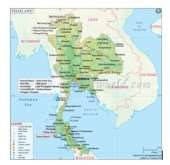 It seems the 1990s never ended. One party has a presidential candidate named Bush, another has a candidate named Clinton; “Full House” is making a comeback, motorists are enjoying unexpectedly low gasoline prices and … the graybeards in and around Washington and London are worried about the currencies of Southeast Asia.
It seems the 1990s never ended. One party has a presidential candidate named Bush, another has a candidate named Clinton; “Full House” is making a comeback, motorists are enjoying unexpectedly low gasoline prices and … the graybeards in and around Washington and London are worried about the currencies of Southeast Asia.
Of course, the 1990s Asia currency crises and those now unfolding are somewhat different. But only just enough to re-assure us that reality moves in spirals, not circles. The 1997 crisis began with Thailand.
Down Memory Lane
Early in ’97 the stock market in that country went bust. Western investors, who had only months before been full of optimism about Thailand, quickly sold out, only to find themselves disappointed at receiving Thai bahts from their counterparties. They converted the Thai bahts into U.S. dollars, and gave a sudden downward momentum to the value of the former.
Part of the problem (and this resonates twenty years later) was that Thailand had an official peg in value, defining the baht against the dollar. So as withdrawing investors sold the baht the central bank had to buy it. Then global macro hedge funds jumped in, also selling the baht, essentially betting they could do for the baht what Soros had famously done for the pound earlier in the decade.
They won that bet on July 1, when the central bank officially cried “Uncle,” abandoning its dollar peg. The crisis spread quickly that summer, to Malaysia, the Philippines, Indonesia , all the “aspiring Tigers” as they were known at the time. Then, in the autumn, on to two of the real Tigers of the region, Hong Kong and the Republic of Korea.
This time around
Well … as everyone knows, the Southeast Asian currency crisis of the mid 2010s began as the bloom came off the Chinese rose. In May of this year Reuters said that China’s economy was “sputtering,” and “headed for its worse year in a quarter of a century.” To some, “sputtering” seemed even then a kind description. On May 26th, the Shanghai Shenzhen CSI 300 hit 5,198.918. Whether the markets were spooked by the proximity of 5,200 or for some more substantive reason, the following three days took it down to below 4,840.
Yet the CSI 300 seemed to shake off those jitters, and resumed a climb, getting above 5,350 in the second week of June. Since then, things have really gotten ugly. The June 19 close, 4,637. The June 29th close, 4,191. From early July into August, the index moved back and forth across the 4,000 line.
That’s where the monetary policy makers in China hit the panic button. On Tuesday, Aug. 11, they devalued their currency 1.9%, bringing it to its weakest level since April 2013, presumably to protect the interests of exporters in a very export-dependent economy. This was described at the time as a “one-off” move. God forbid it be part of a trend! Well. God didn’t forbid that. On Aug. 12, China devalued again, another 1.6%. On Aug. 13, it devalued yet again, another 1%: some one-off.
Again (just as in Thailand’s script from the ‘90s), China’s devaluations acquire extra significance from a long history of a tie to the value of the U.S. dollar, and it appears to many that this is a bumpy road toward the severance of that tie, toward a world in which the values of the CNY and the USD float freely.
Grave implications
Further, and still more obviously, the Chinese devaluations have grave implications for the jurisdictions to the south and east of the PRC. Even on Tuesday, when observers were still accepting the premise that that day’s news was a one-off, Bloomberg’s analysis predicted difficulties to come for South Korea’s won, Taiwan’s dollar, Indonesia’s rupiah, Philippine’s peso, Malaysia’s ringgit, AND Singapore’s dollar: neatly rounding up all the usual suspects.
The central bank in Vietnam widened its currency’s trading band and worried publicly that its northern neighbor’s decision “will have a negative impact” on its own economy.
In Malaysia the situation is especially touchy. At the close of forex trading on July 16, the ESD/MYR exchange rate was 3.8. Ten days later, on July 26, it was still 3.8. By Aug. 6 it had gone to 3.9, and just before China’s devaluations began it was at 3.99. After August 15, that had become 4.08. The ringgit is now in its weakest position since … well … the 1990s. This is where we came in.



